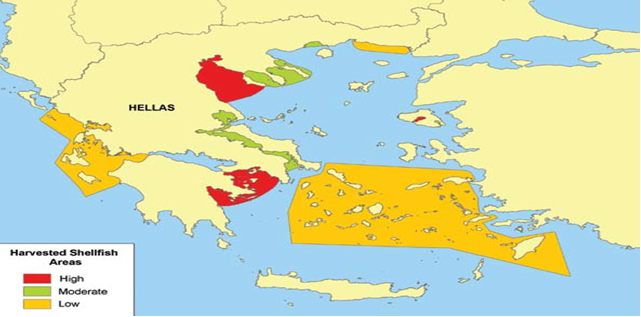Funding: FISHERIES & SEA OPERATIONAL PROGRAM 2014 – 2020, “INNOVATION IN FISHERIES” ARTICLE 26 & 44 par. 3, Reg. 508/2014 Sci.
Responsible: Theodorou Ioannis, Associate Professor, Department of Animal Production, Fisheries and Aquaculture, University of Patras The pearl oyster (oyster oyster, frying pan or oystercatcher).
Pinctada imbricata radiata, originates from the Indo-Pacific region and has been recorded in the Mediterranean as a non-endemic species for about a century (in the Suez Canal in 1883). Since then, it has spread and become “established” in areas of the Levantine Sea (Egypt, Libya, Tunisia, Israel, Cyprus) with a significant presence in Sicily, Malta and nearby islands.
It is an economically viable species to be eaten in the Persian Gulf region, the Red Sea and in several areas in the Mediterranean. In our country today it is a usable catch, especially in areas such as the Saronic Gulf and the Evian Gulf, where edible shellfish are under “pressure” and “depletion” such as quinces, shiny and oysters.
The paradox is that fishing for the species is not included in the current national legislation (PD 86/98, 227/2003, and 109/2002) which regulates the extinction of shellfish and therefore its fishing is prohibited.
It is worth noting that this species is not endangered and therefore does not need protection. The purpose of this proposal is to highlight this species as a “usable catch”.

To set minimum standards for the sustainable management of existing fisheries and to scientifically support the creation of the necessary institutional framework for the existing shellfish resource, in order to eliminate the ‘legislative gap’ that leads to illegal shellfish.
To achieve these goals you should:
a) capture the seasonal variation of the catch.
b) determine the seasonal variation of meat quality and its nutritional value.
c) evaluate packaging, maintenance / freezing protocols, maintenance with various methods of salting and tobacco (liquid) in order to determine the optimal production conditions of new products and to ensure the longevity and stability of the taste and aesthetic characteristics of the innovation.
d) evaluate the innovation from an economic and technical point of view and determine the opinion of the distribution and consumption chain. It is not necessary to propose the institutional framework of specifications for the sustainable catch of the species and the development of new innovative products.
e) diffusion of production know-how, training of the supply chain, consumption.
Research Team
- John Theodorou, Associate Professor, Department of Animal Production, Fisheries and Aquaculture, School of Agricultural Sciences at University of Patras
- George Katselis , Professor, Department of Animal Production, Fisheries and Aquaculture, School of Agricultural Sciences at University of Patras
- Maria Makri Seremeti, Associate Professor, Department of Animal Production, Fisheries and Aquaculture, School of Agricultural Sciences at University of Patras
- Dimitrios K. Moutopoulos, Associate Professor, Department of Animal Production, Fisheries and Aquaculture, School of Agricultural Sciences at University of Patras
- Alexis Ramfos, Associate Professor, Department of Animal Production, Fisheries and Aquaculture, School of Agricultural Sciences at University of Patras
- Xanthipi Douvi,Technical staff, Department of Animal Production, Fisheries and Aquaculture, School of Agricultural Sciences at University of Patras

